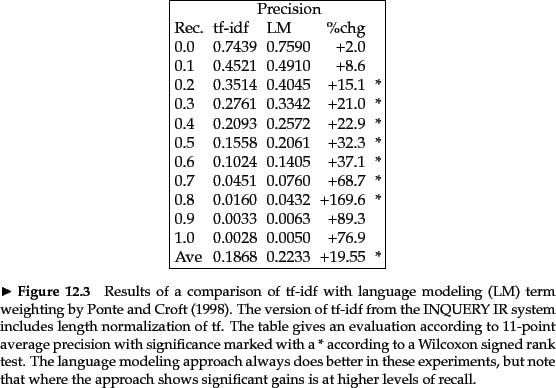
Ponte and Croft (1998) present the first experiments on the
language modeling approach to information retrieval. Their basic
approach is the model
that we have presented until now. However, we have presented an
approach where the language model is a mixture of two multinomials, much
as in (Miller et al., 1999, Hiemstra, 2000) rather than Ponte and
Croft's multivariate
Bernoulli model. The use of multinomials has been standard in most
subsequent work in the LM approach and experimental results in IR, as
well as evidence from text classification which we consider in
Section 13.3 (page ![]() ), suggests that it is superior.
Ponte and Croft argued strongly for the effectiveness of the
term weights that come from the language modeling approach over
traditional tf-idf weights. We present a subset of their results in
Figure 12.4 where they compare tf-idf to language modeling by
evaluating TREC topics 202-250 over TREC disks 2 and 3. The
queries are sentence-length natural language queries. The language
modeling approach yields significantly better results than their
baseline tf-idf
based term weighting approach. And indeed the gains shown here have
been extended in subsequent work.
), suggests that it is superior.
Ponte and Croft argued strongly for the effectiveness of the
term weights that come from the language modeling approach over
traditional tf-idf weights. We present a subset of their results in
Figure 12.4 where they compare tf-idf to language modeling by
evaluating TREC topics 202-250 over TREC disks 2 and 3. The
queries are sentence-length natural language queries. The language
modeling approach yields significantly better results than their
baseline tf-idf
based term weighting approach. And indeed the gains shown here have
been extended in subsequent work.
Exercises.
the martian has landed on the latin pop sensation ricky martin
Build a query likelihood language model for this document collection. Assume a mixture model between the documents and the collection, with both weighted at 0.5. Maximum likelihood estimation (mle) is used to estimate both as unigram models. Work out the model probabilities of the queries click, shears, and hence click shears for each document, and use those probabilities to rank the documents returned by each query. Fill in these probabilities in the below table:
docID Document text 1 click go the shears boys click click click 2 click click 3 metal here 4 metal shears click here
What is the final ranking of the documents for the query click shears?
Query Doc 1 Doc 2 Doc 3 Doc 4 click shears click shears